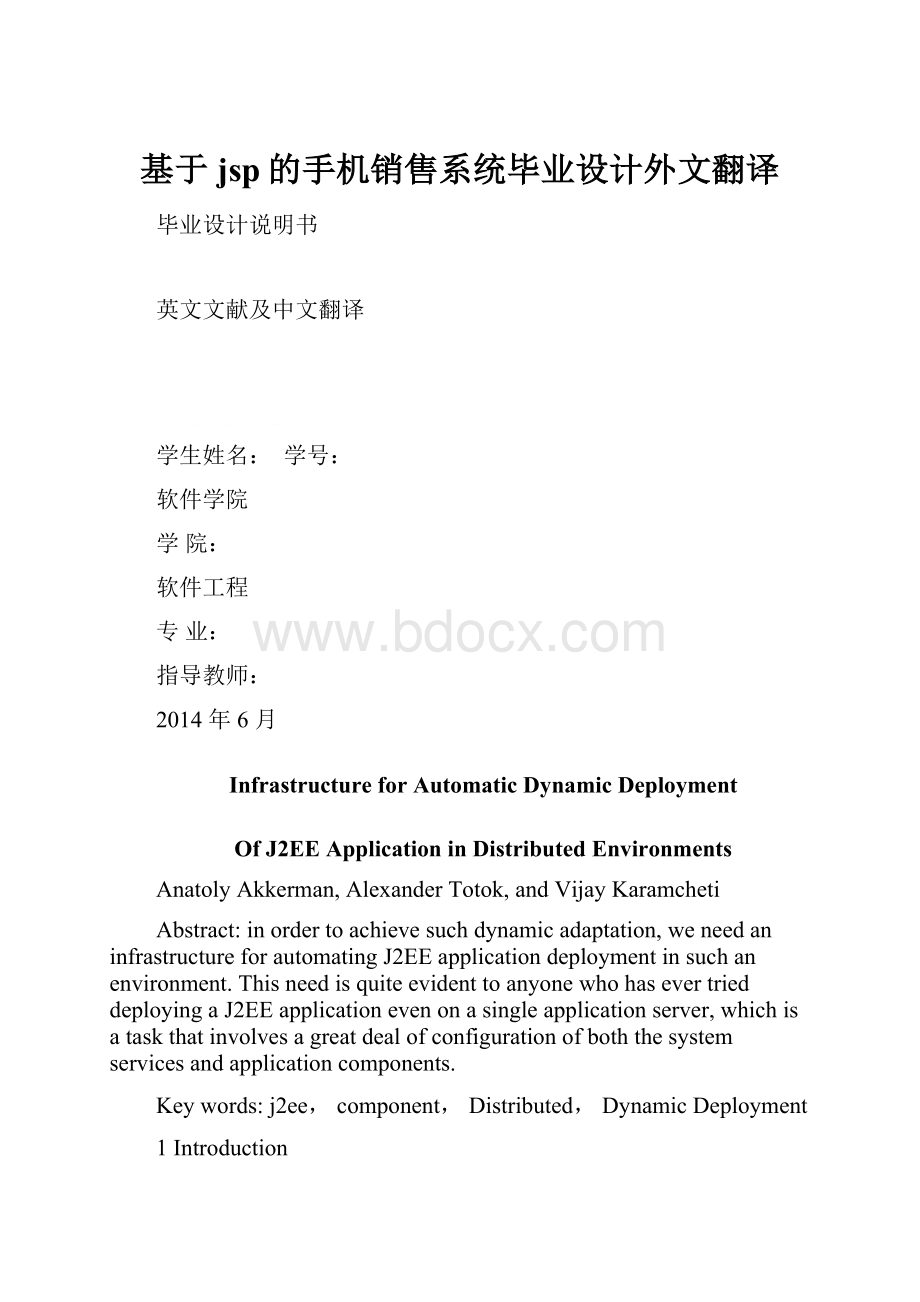基于jsp的手机销售系统毕业设计外文翻译Word文件下载.docx
《基于jsp的手机销售系统毕业设计外文翻译Word文件下载.docx》由会员分享,可在线阅读,更多相关《基于jsp的手机销售系统毕业设计外文翻译Word文件下载.docx(18页珍藏版)》请在冰豆网上搜索。

学号:
软件学院
学院:
软件工程
专业:
指导教师:
2014年6月
InfrastructureforAutomaticDynamicDeployment
OfJ2EEApplicationinDistributedEnvironments
AnatolyAkkerman,AlexanderTotok,andVijayKaramcheti
Abstract:
inordertoachievesuchdynamicadaptation,weneedaninfrastructureforautomatingJ2EEapplicationdeploymentinsuchanenvironment.ThisneedisquiteevidenttoanyonewhohasevertrieddeployingaJ2EEapplicationevenonasingleapplicationserver,whichisataskthatinvolvesagreatdealofconfigurationofboththesystemservicesandapplicationcomponents.
Keywords:
j2ee,component,Distributed,DynamicDeployment
1Introduction
Inrecentyears,wehaveseenasignificantgrowthincomponent-basedenterpriseapplicationdevelopment.TheseapplicationsaretypicallydeployedoncompanyIntranetsorontheInternetandarecharacterizedbyhightransactionvolume,largenumbersofusersandwideareaaccess.Traditionallytheyaredeployedinacentrallocation,usingserverclusteringwithloadbalancing(horizontalpartitioning)tosustainuserload.However,horizontalpartitioninghasbeenshownveryefficientonlyinreducingapplication-relatedoverheadsofuser-perceivedresponsetimes,withouthavingmucheffectonnetwork-inducedlatencies.Verticalpartitioning(e.g.,runningwebtierandbusinesstierinseparateVMs)hasbeenusedforfaultisolationandloadbalancingbutitissometimesimpracticalduetosignificantrun-timeoverheads(evenifonewouldkeepthetiersonafastlocal-areanetwork)relatedtoheavyuseofremoteinvocations.Recentwork[14]inthecontextofJ2EEcomponentbasedapplicationshasshownviabilityofverticalpartitioninginwide-areanetworkswithoutincurringtheaforementionedoverheads.Thekeyconclusionsfromthatstudycanbesummarizedasfollows:
•Usingproperlydesignedapplications,verticaldistributionacrosswide-areanetworksimprovesuser-perceivedlatencies.
•Wide-areaverticallayeringrequiresreplicationofapplicationcomponentsandmaintainingconsistencybetweenreplicas.
•Additionalreplicasmaybedeployeddynamicallytohandlenewrequests.
•Differentreplicasmay,infact,bedifferentimplementationsofthesamecomponentbasedonusage(read-only,read-write).
•Newrequestpathsmayreusecomponentsfrompreviouslydeployedpaths.
Applyingintelligentmonitoring[6]andAIplanning[2,12]techniquesinconjunctionwiththeconclusionsofthatstudy,weseeapotentialfordynamicadaptationinindustry-standardJ2EEcomponent-basedapplicationsinwideareanetworks
Throughdeploymentofadditionalapplicationcomponentsdynamicallybasedonactivemonitoring.However,inordertoachievesuchdynamicadaptation,weneedaninfrastructureforautomatingJ2EEapplicationdeploymentinsuchanenvironment.ThisneedisquiteevidenttoanyonewhohasevertrieddeployingaJ2EEapplicationevenonasingleapplicationserver,whichisataskthatinvolvesagreatdealofconfigurationofboththesystemservicesandapplicationcomponents.ForexampleonehastosetupJDBCdatasources,messagingdestinationsandotherresourceadaptersbeforeapplicationcomponentscanbeconfiguredanddeployed.Inawideareadeploymentthatspansmultipleservernodes,thisprovesevenmorecomplex,sincemoresystemservicesthatfacilitateinter-nodecommunicationsneedtobeconfiguredandstartedandavarietyofconfigurationdata,likeIPaddresses,portnumbers,JNDInamesandothershavetobeconsistentlymaintainedinvariousconfigurationfilesonmultiplenodes.
Thisdistributeddeploymentinfrastructuremustbeableto:
•addressinter-componentconnectivityspecificationanddefineitseffectsoncomponentconfigurationanddeployment,
•addressapplicationcomponentdependenciesonapplicationserverservices,theirconfigurationanddeployment,
•providesimplebutexpressiveabstractionstocontroladaptationthroughdynamicdeploymentandundeploymentofcomponents,
•enablereuseofservicesandcomponentstomaintainefficientuseofnetworknodes’resources,
•providethesefacilitieswithoutincurringsignificantadditionaldesigneffortonbehalfofapplicationprogrammers.
InthispaperweproposetheinfrastructureforautomaticdynamicdeploymentofJ2EEapplications,whichaddressesalloftheaforementionedissues.Theinfrastructuredefinesarchitecturedescriptionlanguages(ADL)forcomponentandlinkdescriptionandassembly.TheComponentDescriptionLanguageisusedtodescribeapplicationcomponentsandlinks.Itprovidesclearseparationofapplicationcomponentsfromsystemcomponents.Aflexibletypesystemisusedtodefinecompatibilityofcomponentportsandlinks.Adeclarationandexpressionlanguageforconfigurablecomponentpropertiesallowsforspecificationofinter-componentdependenciesandpropagationofpropertiesbetweencomponents.TheComponent(Replica)AssemblyLanguageallowsforassemblyofreplicasofpreviouslydefinedcomponentsintoapplicationpathsby
Connectingappropriateportsvialinkreplicasandspecifyingthemappingofthesecomponentreplicasontotargetapplicationservernodes.TheComponentConfigurationProcessevaluatesanapplicationpath’scorrectness,identifiesthedependencies
ofapplicationcomponentsonsystemcomponents,andconfigurescomponentreplicasfordeployment.Anattemptismadetomatchandreuseanypreviouslydeployedreplicasinthenewpathbasedontheirconfigurations.WeimplementtheinfrastructureasapartoftheJBossopensourceJavaapplicationserver[11]andtestitonseveral
SampleJ2EEapplications–JavaPetstore[23],Rubies[20]andTPC-W-NYU[32].TheinfrastructureimplementationutilizestheJBoss’sextendablemicro-kernelarchitecture,basedontheJMX[27]specification.ComponentizedarchitectureofJBossallowsincrementalservicedeploymentsdependingontheneedsofdeployedapplications.Webelievethatdynamicreconfigurationofapplicationserversthroughdynamicdeploymentandundeploymentofsystemservicesisessentialtobuildingaresource-efficientframeworkfordynamicdistributeddeploymentofJ2EEapplications.Therestofthepaperisorganizedasfollows.Section2providesnecessarybackgroundforunderstandingthespecificsoftheJ2EEcomponenttechnologywhicharerelevanttothisstudy.Section3givesageneraldescriptionoftheinfrastructurearchitecture,whilesection4goesdeeperindescribingparticularlyimportantandinterestinginternalmechanismsoftheinfrastructure.Section5describestheimplementationoftheframework,andrelatedworkisdiscussedinsection6.
2J2EEBackground
2.1Introduction
Componentframeworks.Acomponentframeworkisamiddlewaresystemthatsupportsapplicationsconsistingofcomponentsconformingtocertainstandards.Applicationcomponentsare“plugged”intothecomponentframework,whichestablishestheirenvironmentalconditionsandregulatestheinteractionsbetweenthem.Thisisusuallydonethroughcontainers,componentholders,whichalsoprovidecommonlyrequiredsupportfornaming,security,transactions,andpersistence.Componentframeworksprovideanintegratedenvironmentforcomponentexecution,asaresultsignificantlyreducetheeffort.ittakestodesign,implement,deploy,andmaintainapplications.CurrentdayindustrycomponentframeworkstandardsarerepresentedbyObjectManagementGroup’sCORBAComponentModel[18],SunMicrosystems’Java2PlatformEnterpriseEdition(J2EE)[25]andMicrosoft’s.NET[17],withJ2EEbeingcurrentlythemostpopularandwidelyusedcomponentframeworkintheenterprisearena.
J2EE.Java2PlatformEnterpriseEdition(J2EE)[25]isacomprehensivestandardfordevelopingmulti-tierenterpriseJavaapplications.TheJ2EEspecificationamongotherthingsdefinesthefollowing:
•Componentprogrammingmodel,
•Componentcontractswiththehostingserver,
•Servicesthattheplatformprovidestothesecomponents,
•Varioushumanroles,
•Compatibilitytestsuitesandcompliancetestingprocedures.
Amongthelistofservicesthatacompliantapplicationservermustprovidearemessaging,transactions,namingandothersthatcanbeusedbytheapplicationcomponents.ApplicationdevelopedusingJ2EEadheretotheclassical3-Tierarchitectures–PresentationTier,BusinessTier,andEnterpriseInformationSystem(EIS)Tier(seeFig.1).J2EEcomponentsbelongingtoeachtieraredevelopedadheringtothe
SpecificJ2EEstandards.
1.PresentationorWebtier.
Thistierisactuallysubdividedintoclientandserversides.Theclientsidehostsawebbrowser,appletsandJavaapplicationsthatcommunicatewiththeserversideofpresentationtierorthebusinesstier.TheserversidehostsJavaServletcomponents[30],JavaServerPages(JSPs)[29]andstaticwebcontent.Thesecomponentsareresponsibleforpresentingbusinessdatatotheendusers.ThedataitselfistypicallyacquiredfromthebusinesstierandsometimesdirectlyfromtheEnterpriseInformationSystemtier.TheserversideofthepresentationtieristypicallyaccessedthroughHTTP(S)protocol.
2.BusinessorEJBtier.
ThistierconsistsofEnterpriseJavaBeans(EJBs)[24]thatmodelthebusinesslogicoftheenterpriseapplication.Thesecomponentsprovidepersistencemechanismsandtransactionalsupport.ThecomponentsintheEJBtierareinvokedthroughremoteinvocations(RMI),in-JVMinvocationsorasynchronousmessagedelivery,dependingonthetypeofEJBcomponent.TheEJBspecificationdefinesseveraltypesofcomponents.Theydifferininvocationstyle(synchronousvs.asynchronous,localvs.remote)andstatefulness:
completelystateless(e.g.,Message-DrivenBean),statefulnon-persistent
(e.g.,StatefulS